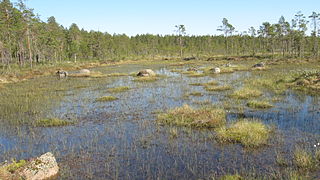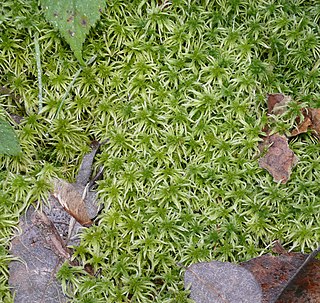
A bog or bogland is a wetland that accumulates peat as a deposit of dead plant materials – often mosses, typically sphagnum moss. It is one of the four main types of wetlands. Other names for bogs include mire, mosses, quagmire, and muskeg; alkaline mires are called fens. A bayhead is another type of bog found in the forest of the Gulf Coast states in the United States. They are often covered in heath or heather shrubs rooted in the sphagnum moss and peat. The gradual accumulation of decayed plant material in a bog functions as a carbon sink.

Sphagnum is a genus of approximately 380 accepted species of mosses, commonly known as sphagnum moss, also bog moss and quacker moss. Accumulations of Sphagnum can store water, since both living and dead plants can hold large quantities of water inside their cells; plants may hold 16 to 26 times as much water as their dry weight, depending on the species. The empty cells help retain water in drier conditions.

Aulacomnium palustre, the bog groove-moss or ribbed bog moss, is a moss that is nearly cosmopolitan in distribution. It occurs in North America, Hispaniola, Venezuela, Eurasia, and New Zealand. In North America, it occurs across southern arctic, subboreal, and boreal regions from Alaska and British Columbia to Greenland and Quebec. Documentation of ribbed bog moss's distribution in the contiguous United States is probably incomplete. It is reported sporadically south to Washington, Wyoming, Georgia, and Virginia.

Sphagnum angustifolium, the fine bogmoss, is a species of peat moss with a Holarctic distribution. A member of the S. recurvum species complex within Sphagnum section Cuspidata, it is a relatively small, green to yellowish moss that grows in wet, moderately nutrient-rich mires, typically forming carpets or growing intermixed with other peat moss species. The species can be distinguished from its close relatives by having no more than four branches per fascicle and distinctive large pores on its hanging branch leaves, though identification becomes more challenging in southern populations where morphological characteristics are less distinct.

Sphagnum girgensohnii, commonly known as Girgensohn's bogmoss, Girgensohn's sphagnum or common green peat moss, is a species of peat moss with a Holarctic and Indo-Malesian distribution. First described by Edmund Russow in 1865, it is a relatively robust moss species characterised by its green to straw-coloured appearance and distinctive branching pattern. The species typically grows in shaded, damp woodlands and on the edges of mires, forming loose mats particularly under birch and willow trees, and can be found from sea level to elevations of 2,200 metres. While it shows a mainly northern distribution pattern and is especially abundant in subarctic regions, it occurs throughout Europe from Portugal to Russia, being more common in upland areas. Despite facing threats from habitat degradation and land-use changes, S. girgensohnii is assessed by the IUCN as Least Concern due to its extensive range and stable populations, though it receives legal protection under various national and international frameworks, including the EU Habitats Directive.

Potamogeton polygonifolius or bog pondweed is an aquatic plant. It is found in shallow, nutrient-poor, usually acid standing or running water, bogs, fens and occasionally ditches.

Sphagnum palustre, the prairie sphagnum or blunt-leaved bogmoss, is a species of peat moss from the genus Sphagnum, in the family Sphagnaceae. Like other mosses of this type it can soak up water up to the 30-fold amount of its own dry weight thanks to its elastic spiral fibers. S. palustre is rather frequent and is spread almost all over the world. It mainly grows in wet forests and—compared to other specimens of this genus—rarely grows in moors.

Empodisma minus, commonly known as (lesser) wire rush or spreading rope-rush, is a perennial evergreen belonging to the southern-hemisphere family of monocotyledonous plants Restionaceae. The Latin name Empodisma minus translates to “tangle-foot” “small”. E. minus is found from Queensland to South Australia, Tasmania and throughout New Zealand south of 38 ° latitude, or the central north island. Its current conservation status is “Least concern”. In 2012, the new species Empodisma robustum was described in New Zealand, with what was previously described as E. minus from the lowland raised bogs of Waikato and Northland now being re-classified as E. robustum. E. minus remains an important peatformer in the south of New Zealand and in high altitude peatlands.

Sphagnum capillifolium, the red bogmoss, northern peat moss, acute-leaved bog-moss, or small red peat moss, is a species of peat moss native to Canada, the northern United States, Greenland, and Europe. Small red peat moss can be distinguished by its sweeping, outward-curving branches that resemble tresses. Sphagnum moss can hold large amounts of water within its cells, up to 20 times its own weight. This capability is due to its dead, empty cells called hyaline cells that fill up with water. This allows the moss to survive in wet, boggy habitats around rivers and lakes.

Sphagnum squarrosum, commonly known as the spiky bog-moss or spreading-leaved bog moss, is a peat moss species found in nutrient-rich, damp soils and wetlands across the Northern Hemisphere, with isolated populations in South America. Its spiky appearance, resulting from strongly spreading branch leaves, distinguishes it from other peat moss species. Playing an important role in wetland succession, the species is one of the first Sphagnum mosses to colonise developing wetlands. It shows considerable tolerance to mineral-rich conditions and actively modifies its habitat through cation exchange processes.

Sphagnum cuspidatum, the feathery bogmoss, toothed sphagnum, or toothed peat moss, is a peat moss found commonly in Great Britain, Norway, Sweden, the eastern coast of the United States, and in Colombia.

Sphagnum fimbriatum, the fringed bogmoss, is a peat moss found in temperate regions worldwide, from the Arctic to New Zealand and along the Andes. William Wilson formally described the species in 1846. Plants measure up to 10 cm (4 in) tall, varying from slender to moderately robust forms. It forms loose carpets or soft mounds in wetlands and is identified by its stem leaves with fringed upper margins. The stem leaves distinguish it from other Sphagnum species, including its close relative S. girgensohnii which has rectangular stem leaves fringed only at the tip.
Paludiculture is wet agriculture and forestry on peatlands. Paludiculture combines the reduction of greenhouse gas emissions from drained peatlands through rewetting with continued land use and biomass production under wet conditions. “Paludi” comes from the Latin “palus” meaning “swamp, morass” and "paludiculture" as a concept was developed at Greifswald University. Paludiculture is a sustainable alternative to drainage-based agriculture, intended to maintain carbon storage in peatlands. This differentiates paludiculture from agriculture like rice paddies, which involve draining, and therefore degrading wetlands.

Sphagnum papillosum, the papillose peatmoss, is a species of peat moss distributed throughout the northern hemisphere. Although sometimes confused with Sphagnum imbricatum and Sphagnum palustre, it is distinguished by its yellow-green to brown short, blunt branches and papillose chlorophyllose cells.
Sphagnum platyphyllum, the flat-leaved bogmoss, is a species of moss in the family Sphagnaceae. It is a circumpolar peat moss found in arctic and subarctic regions of Europe and Asia, with populations also occurring in North America. The species typically grows in loose mats in wet, moderately nutrient-rich environments, particularly in areas dominated by sedges and locations that experience seasonal flooding. First described as a variety in 1875 and elevated to species status in 1884, it belongs to the subgenus Subsecunda within the "Pacific Rim clade". While most populations are haploid, the species shows evidence of a complex evolutionary history, including rare allodiploid populations. Although widely distributed and classified as a least-concern species globally, it faces varying levels of conservation concern across its range, being critically endangered in several European countries due to habitat degradation, peat extraction, and climate change. The species is distinctive among peat mosses for its poorly developed capitula with protruding stem buds, and its dioecious reproduction, with male plants and spore-producing structures being rare in many regions.

Sphagnum wulfianum, commonly known as Wulf's peatmoss, is a species of moss belonging to the family Sphagnaceae. It has a circumboreal distribution, occurring primarily in moist boreal forest environments across Eurasia and North America, with rare occurrences in Arctic tundra regions. The species is morphologically distinctive among peat mosses, characterised by having six to twelve branches per fascicle, a unique feature in the genus. First described in 1860 from Estonia, it typically grows in boggy mineral-rich spruce forests and at the borders of mires, forming small carpets and hummocks. While the species has a large geographic range and stable overall population trends in Europe, it faces regional conservation challenges, particularly at its range edges, where it is considered endangered in several countries due to habitat degradation from peatland drainage, forestry, and agriculture. Genetic studies indicate remarkably low genetic diversity throughout its range, suggesting high rates of gene flow across large distances despite infrequent spore production.

Sphagnum rubellum, commonly known as the red peat moss, is a species of peat moss in the family Sphagnaceae. It forms low, reddish cushions in wet areas like bogs and poor fens across North America and Eurasia, particularly in regions with oceanic climates. The species can vary in colour from green to pink or deep crimson, and grows up to 10 cm (3.9 in) tall. Like other peat mosses, it plays an important role in forming and maintaining peatlands.

Fissidens taxifolius, the common pocket moss, is a species of moss in the family Fissidentaceae. First described by Johann Hedwig in 1801, it is a small to medium-sized moss that typically grows in dense, yellowish-green to dark green tufts. The species is characterised by its distinctive flattened appearance, with leaves arranged in two opposite rows resembling tiny fern fronds, and by its pointed leaf tips with projecting central nerves. It can grow in artificial light and is known to form extensive turfs in suitable conditions.

Sphagnum australe is a species of Sphagnum found in southeastern Australia.

Sphagnum teres, or rigid bogmoss, is a species of moss from the Sphagnaceae family. Widely distributed in the Northern Hemisphere, it grows in mountainous areas in the southern part of its range. It thrives in fertile, minerotrophic peatlands. It is characterized by a clearly visible terminal bud in the middle part of the head and usually a dark brown stem.























